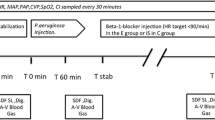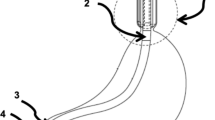Abstract
Objective: To evaluate the possible related factors to endotoxemia and cytokine activation during the ischemic phase of extracorporeal surgery, and the effect of selective digestive decontamination (SDD) as a preventive measure.
Design: Prospective, open, randomized trial.
Setting: Two multidisciplinary ICUs (tertitary care hospitals).
Patients: One hundred consecutive patients undergoing cardiopulmonary bypass (CPB), randomly allocated to two groups: gut decontamination (group I=50 cases) and controls (group II=50 cases).
Interventions: Preoperative administration of oral non-absorbable antibiotics (polymyxin E, tobramycin and amphotericin B) versus no administration.
Measurements and results: The assessment of decontamination by means of the bacteriologic control of rectal swabs. Determinations of gastric intramucosal pH (gastric pHi) and plasma endotoxin, tumor necrosis factor (TNF) and interleukin-6 (IL-6) before surgery and during the ischemic and reperfusion phases of bypass. Rectal aerobic Gram-negative bacilli (AGNB) were significantly reduced in the treated patients and in 56 % total eradication was achieved. Endotoxin, TNF and IL-6 plasma levels were significantly lower in this group. By contrast, both endotoxin and TNF/IL-6 levels and gastric pHi correlated with the type of surgical flow (pulsatile versus non-pulsatile).
Conclusions: SDD reduces the gut content of enterobacteria. This may explain the lower endotoxin and cytokine levels detected in decontaminated patients. In addition to SDD, the type of flow employed during bypass seems to influence endotoxemia and cystokine levels.
Similar content being viewed by others
References
Thijs LG, Hack CE (1991) The orchestra of mediators in the pathogenesis of septic shock: A review. In: IL Vincent (ed) Update in intensive care and emergency medicine. Springer, Berlin New York, pp 232–247
Browin JM, Grosso MA (1989) Cytokines, sepsis and the surgeon. Surg Gynecol Obstet 169: 568–574
Fiddian-Green RG (1990) Gut mucosal ischemia during cardiac surgery. J Thorac Cardiovasc Surg 4: 389–399
Andersen LW, Landow L, Baek L, Jansen E, Baker S (1993) Association between gastric intramucosal pH and splanchnic endotoxin, antibody to endotoxin and tumor necrosis factor concentrations in patients undergoing cardiopulmonary bypass. Crit Care Med 21: 210–217
Andersen LM, Baeck L, Degn H, Ilchd J, Lasnik M, Rasmussen JP (1987) Presence of circulating endotoxins during cardiac operations. J Thorac Cardiovasc Surg 93: 115–119
Rocke DA, Gaffin SL, Wells MT, Koen Y, Brock-Utine JG (1987) Endotoxemia associated with cardiopulmonary bypass. J Thorac Cardiovasc Surg 93: 832–837
Oudemans-van Straaten HM, Jansen PGM, Te Velthuis H, Beenakkers ICM, Stoutenbeek CP, Van Deventer SJH, Sturk A, Eysman L, Wildevuur Ch RH (1996) Increased oxygen consumption after cardiac surgery is associated with the inflammatory response to endotoxemia. Intensive Care Med 22: 294–300
Ziegler EJ, Fisher CJ Jr, Sprung CL, Straube RC, Sadoff JC, Foulke GE, and the Ha-IA sepsis study group (1991) Treatment of gram-negative bacteremia and septic shock with HA-1A human monoclonal antibody against endotoxin. N Engl J Med 324: 429–436
Pinsky MR, Vincent JL, Deviers J, Alegre M, Kahn RJ, Dupont E (1993) Serum cytokine levels in human septic shock: relation to multiple-system organ failure and mortality. Chest 103: 565–575
Abraham E, Wunderink R, Silverman H, Perl TM, Nasraway S, Levy H, Bone R, Wenzel RP, Balk R, Allred R, Pennington JE, Wherry JC (1995) Efficacy and safety of monoclonal antibody to human tumor necrosis factor in patients with sepsis syndrome. JAMA 273: 934–941
Stoutenbeek CP, Van Saene HKF, Miranda DR, Zandstra DF (1984) The effect of selective decontamination of the digestive tract on colonisation and infection rate in multiple trauma patients. Intensive Care Med 10: 185–192
Martinez-Pellüs AE, Merino P, Bru M, Conejero R, Seller G, Muñoz C, Fuentes T, Gonzalez G, Alvarez B (1993) Can selective digestive decontamination avoid the endotoxemia and cytokine activation promoted by cardiopulmonary bypass? Crit Care Med 21: 1684–1691
Heard SO, Helsmoortel CM, Kent JC, Shahnarian A, Fink MP (1991) Gastric tonometry in healthy volunteers: effect of ranitidine on calculated intramural gastric pHi. Crit Care Med 19: 271–274
Deitch EA (1990) The role of intestinal barrier failure and bacterial translocation in the development of systemic infection and multiple organ failure. Arch Surg 125: 403–404
Alexander JW, Boyce ST, Babcock GF, Gianotti L, Peck MD, Dunn DL, Pyles T, Childress Ch, Ash SK (1990) The process of bacterial translocation. Ann Surg 212: 496–501
Van Saene JJM, Stoutenbeek CP, Van Saene HKF (1989) Significant reduction of faecal endotoxin pool by oral polymyxin E and tobramycin in human volunteers. In: JL Vincent (ed) Update in intensive care and emergency medicine. Springer, Berlin New York, pp 128–134
De Camp MM, Demling R (1988) Posttraumatic multisystem organ failure. JAMA 260: 530–534
Danner RL, Elin RJ, Hosseini JM, Wesley RA, Reilly JM, Parrillo JE (1991) Endotoxemia in human septic shock. Chest 99 (1): 169–175
Meyrick BO, Ryan VA, Brigham KL (1986) Direct effect of E Coli endotoxin on structure and permeability of pulmonary endothelial non-layers and the endothelial layer of intestinal explants. Am J Pathol 122: 140–155
Ohri SK, Somasundaram S, Koak Y, Macpherson A, Keogh BE, Taylos KM, Menzies IS, Bjarnason Y (1994) The effect of intestinal hypoperfusion on intestinal absorption and permeability during cardiopulmonary bypass. Gastroenterology 106: 318–323
Taylor KM (1989) Vasopressor release and multiple organ failure in cardiac surgery. In: Marston A, Bulkley GB, Fiddian-Green RG, et al. (eds) Splanchnic ischemia and multiple organ failure. Mosby, St Louis, pp 89–99
Casey WF, Hauser GJ, Hannallah RS, Midgley FM, Khan WN (1992) Circulating endotoxin and tumor necrosis factor during pediatric cardiac surgery. Crit Care Med 20: 1090–1096
Baue AE (1993) The role of the gut in the development of multiple organ dysfunction in cardiothoracic patients. Ann Thorac Surg 55: 822–829
Riddington DW, Venkatesh B, Boivin ChM, Bonser RS, Elliot TSJ, Marshall T, Mountford PJ, Bion JF (1996) Intestinal permeability, gastric intramucosa pH and systemic endotoxemia in patients undergoing cardiopulmonary bypass. JAMA 275: 1007–1012
SDD trialist collaborative group (1993) Meta-analysis of randomized controlled trials on the effect of selective decontamination of the digestive tract. BMJ 307: 525–532
Fox MA, Peterson S, Fabri BM, Van Saene HKF, Williets T (1991) Selective decontamination of the digestive tract in cardiac surgical patients. Crit Care Med 19: 1486–1490
Basha M, Meyer GS, Kunkel SL, Strieter RM, Rivers ED, Popovich J (1991) Presence of tumor necrosis factor in humans undergoing cardiopulmonary resuscitation with return of spontaneous circulation. J Crit Care 6 (4): 185–189
Michie HR, Manoque KR, Spriggs DR, Revhaug A, O’Dwyer S, Dinarello ChA, Cerami A, Wolf SM, Wilmore DN (1988) Detection of circulating tumor necrosis factor after endotoxin administration. N Engl J Med 318: 1481–1486
Colleti LM, Remick DG, Burtch GD, Kunkel SL, Strieker RM, Campbell DA (1990) Role of tumor necrosis factor-alpha in the pathophysiologic alterations after hepatic ischemia/reperfusion injury in the rat. J Clin Invest 85: 1936–1943
Author information
Authors and Affiliations
Additional information
This study was supported by a grant from the Social Security Health Investigation Fund (FISS)
Rights and permissions
About this article
Cite this article
Martinez-Pellús, A.E., Bru, M., Seller, G. et al. Endogenous endotoxemia of intestinal origin during cardiopulmonary bypass. Intensive Care Med 23, 1251–1257 (1997). https://doi.org/10.1007/s001340050494
Received:
Accepted:
Issue Date:
DOI: https://doi.org/10.1007/s001340050494




